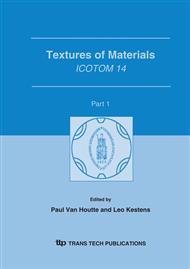p.1627
p.1633
p.1639
p.1645
p.1653
p.1657
p.1665
p.1675
p.1681
The Application of ODF Analysis for Drawing Sheet of Weak Textured Materials
Abstract:
For multi crystal materials, particularly multi-crystal metallic materials, it is unavoidable to make its crystal orientation change during the process. For instance, improving the property of soft magnetic materials should rely on the Cubic texture {100} <001>, but the property of the deep-draw sheet materials is closely related to its texture. Besides the material's composition, the crystal and the microstructure, the texture also takes a very important role in the properties of the materials [1, 2]. The positive pole figure analytic method is comparatively simple and intuitional. This is unquestionable in the texture analysis of cold-rolled samples, as in drawing sheet materials. It shows that the material orientation of isotropy or multiple weak textured materials is coexistent. The ODF analysis can be a good method for resolving this. In the study, the serial ODF analysis is used to analyze the property of nickel based alloys of drawing sheet materials considering different deformation amount, annealing temperature and annealing time in layers. In practice, it can be applied to production techniques.
Info:
Periodical:
Pages:
1653-1656
Citation:
Online since:
September 2005
Authors:
Price:
Сopyright:
© 2005 Trans Tech Publications Ltd. All Rights Reserved
Share:
Citation:


